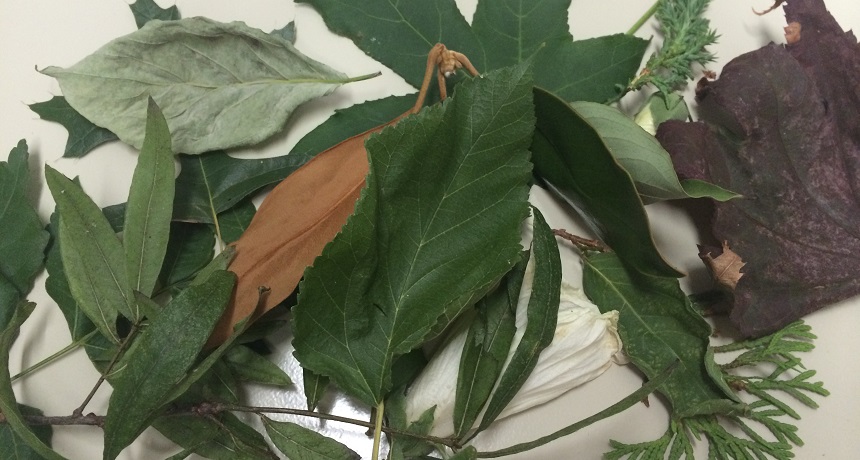Free app for tree ID needs work
This program to identify local leaves exhibits some technological hiccups

To test out the Leafsnap app, I picked a pile of leaves to identify. Unfortunately, the app’s technical difficulties did not make my task easy.
B. Brookshire/SSP
When you’re on a hike, or just wandering around your neighborhood, you might come across a tree or other leafy green plant and wonder what it is. Unfortunately, figuring that out can mean digging up a guidebook or spending a long time downloading images and entries from the Internet. A new app pledges to make tree identification a snap. And it delivers — but not as well you might hope.
Leafsnap is a free app available for the iPhone or iPad. It offers leaf guides, plant games and a leaf-recognition program. Each helps you put a name to the tree that dropped the leaf you’re looking at. Unfortunately, while the pictures are excellent and there is a lot of information available, Leafsnap is poorly organized, difficult to understand and has some technical limits.
Computer scientists and botanists developed the app. The team includes researchers from University of Maryland in College Park and Columbia University in New York City. They took techniques that some forensic teams use to help computers recognize faces and applied them to leaves.
Take a photo of the leaf using the app and input your geographic location. The app then matches the leaf to types of trees typically found in your region. Botanists at the Smithsonian National Museum of Natural History in Washington, D.C. provided the photos of hundreds of leaves, flowers and fruits. The photos are the references that help the app identify your plant.
When you open Leafsnap, you have the option to play games, browse local species or snap your own leaf photo. The last is the identification option. If that’s what you want, lay your unknown leaf flat on a white background (such as a paper napkin, sheet of printer paper or handkerchief). Center it on the camera’s screen and snap a photo. But be forewarned: The app also doesn’t respond well if your leaf is curly. It also doesn’t seem to like a large compound leaf with many small leaflets.
When you ask the app to analyze your photo, keep in mind that it requires a wireless Internet connection. Without it, it will be impossible to identify species in the field. For it to work for me, I had to bring a large bunch of leaves back to my office.
When you upload your leaf, the app presents you with a list of possible matches to your specimen. When you find the perfect match, you can swipe your screen to label your leaf. The app uses common names such as “flowering dogwood” or “sugar maple” to make labeling easier. But there’s not a lot of other guidance. When my leaf didn’t immediately match something I recognized, many of the options were difficult to tell apart. Is it this round leaf? Or that round leaf? How do you tell the difference? Unfortunately, Leafsnap doesn’t appear to provide the answer. Some tips, such as which way the veins of the leaf point, might have helped to tell one leaf from another. There is some description in the app, but it tends to be in scientific language that is difficult for a non-botanist to parse.
Leafsnap does offer several entertaining games. They ask you to match leaves, flowers and fruit to their species. Unfortunately, when I tried match leaves or flowers with their tree names, the app had a tendency to shut down. Similarly, the app shut down several times when I tried to access the camera function to identify a leaf. I often had to restart the app several times before it would function correctly.
There are few instructions or guides on how to use this program. All the most helpful instructions on the website are hidden in the section titled ‘frequently asked questions,’ or FAQs. These are buried under the “About” page. I tapped and jabbed at my screen to no avail before finally stumbling accidentally on the swipe technique in the FAQs.
The best function of Leafsnap is the “browse” section. The app showcases a large selection of trees found in the northeastern United States, New York and the area around Washington, D.C. There is also a version for the United Kingdom. Excellent pictures highlight the leaves, flowers, fruit and bark of each tree species covered. A tiny book icon at the top right offers a description and notes on habitat and growth.
Want to identify a shrub or other big bushy plant? You’re out of luck. This is a tree-only app.
While the pictures are excellent and the written descriptions are helpful, the rest of the app still needs work. Hopefully updates will make identifying samples more self-explanatory and stop the app from spontaneously shutting down. At least there’s no cost to playing with this app — other than your time.
Rating: 
One out of five leaves.
Free, Available on iTunes for iPhone and iPad.
Follow Eureka! Lab on Twitter
Power Words
app Short for application, or a computer program designed for a specific task.
botany The field of biology that focuses on plants. The scientist in this field is known as a botanist.
computer science The scientific study of the principles and use of computers.
habitat The area or natural environment in which an animal or plant normally lives, such as a desert, coral reef or freshwater lake. A habitat can be home to thousands of different species.
software The mathematical instructions that direct a computer’s hardware, including its processor, to perform certain operations.